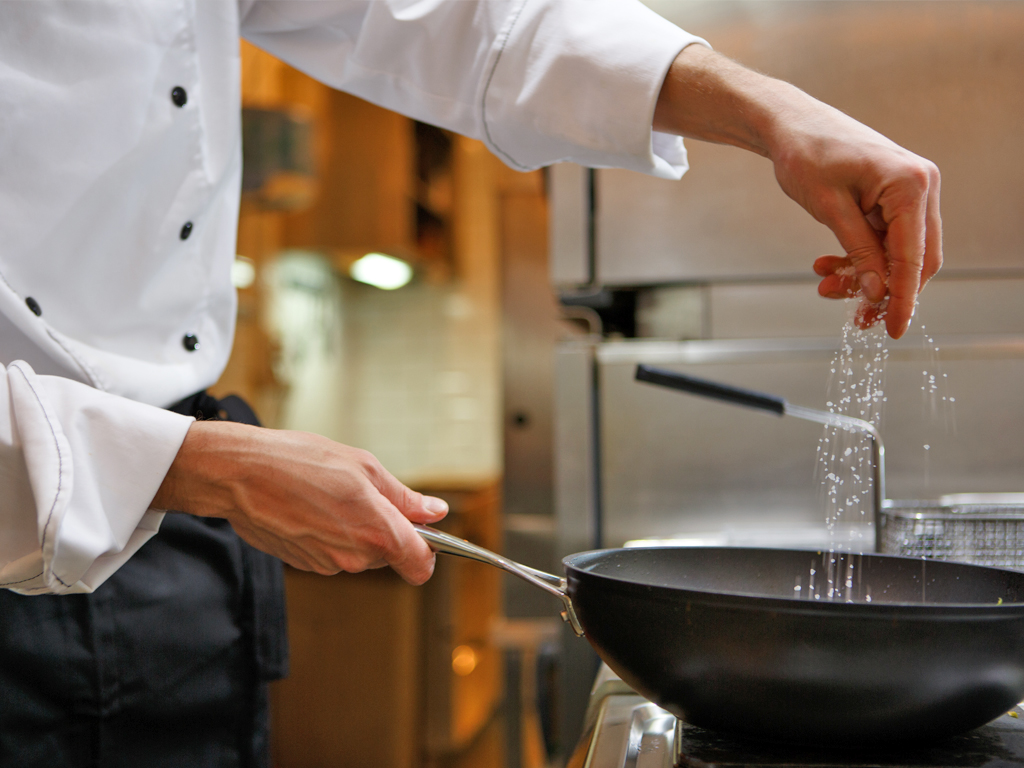
Sì Chef!
Storie, aneddoti, pietanze. Sei racconti capresi, sei cucine differenti. Dove l’ingrediente più importante è sempre la passione
di Antonella Maresca | foto di Davide Esposito
Spaghetto con le vongole “fujute”. Nella tradizione quando fuggono le vongole rimane la bontà di uno spaghetto aglio e olio. È questo il sapore della cucina caprese.
Semplice come la genuinità degli ingredienti, complesso nella sua riuscita, buono come l’ultimo spaghetto del piatto. Un filo di grano duro lungo cui si dipanano curiosità, identità, materie prime eccelse, semplicità. Cucine tutte diverse che hanno le stesse basi, quelle della passione e della voglia di fare sempre meglio. Il mare che circonda l’isola forgia gli interpreti della cucina isolana o li conduce sulle sue coste.
C’è chi ci è nato, chi è approdato per fare un giro, chi è stato chiamato come l’invocazione di una musa, chi se ne è innamorato al primo passo sulle rocce calcaree, chi si sente avvolto dal magnetismo dell’isola, chi ha trovato l’amore e ha messo radici, chi ha ritrovato il Sud che aveva lasciato.
Sei chef, sei racconti capresi, sei cucine differenti. Mani diverse che raccontano le loro storie, i loro vissuti e la loro crescita nei piatti che servono a tavola, portata dopo portata, creazione dopo creazione.
L’inverno è il cuore della cucina caprese. Quando l’isola riposa, i suoi cuochi vanno in giro alla ricerca di sapori, emozioni e colori. Scoprono in nuove terre e in nuove cucine cosa possono importare sull’isola, quale ingrediente aggiungere, quali sapori abbinare, che bagaglio portare per far assaporare la stessa isola con nuovi occhi perché, dopo aver girato il mondo in inverno, d’estate è il mondo che si siede ai loro tavoli.
«Quando si cucina si trasmette il proprio io. Bisogna farlo con un’anima leggera e con il cuore che batte» dice Andrea 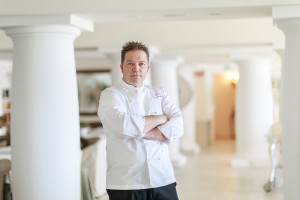 Migliaccio, oggi executive chef del Riccio e del ristorante l’Olivo del Capri Palace, entrambi stellati. Originario di un’altra isola del Golfo, Ischia, cresce con nonna Tina, che gli insegna ad apprezzare il profumo del ragù napoletano, della parmigiana di melanzane e delle polpette fritte mentre si faceva aiutare nelle piccole cose della cucina casareccia tra un goccio di olio in più e un piatto “scardato”.
Migliaccio, oggi executive chef del Riccio e del ristorante l’Olivo del Capri Palace, entrambi stellati. Originario di un’altra isola del Golfo, Ischia, cresce con nonna Tina, che gli insegna ad apprezzare il profumo del ragù napoletano, della parmigiana di melanzane e delle polpette fritte mentre si faceva aiutare nelle piccole cose della cucina casareccia tra un goccio di olio in più e un piatto “scardato”.
È qui che acquista la manualità che approfondisce nelle sue prime esperienze, in particolare quella con Nino Di Costanzo da cui apprende la cura, l’estetica e l’arte dell’impiattamento. La sua strada si incrocia con Capri, dove non era mai stato, nel 2005 affiancando lo chef Oliver Glowing e si innamora della filosofia del Capri Palace.
Dopo non molto tempo gli affidano la cucina del Riccio, dove per giorni si lascia ispirare dalla location a pochi passi dalla Grotta Azzurra prima di concepire un menù di mare elegante e pulito, mediterraneo e tradizionale. Successivamente, inizia a seguire anche la cucina dell’Olivo con un menù più complesso e strutturato coadiuvato da Salvatore Elefante e Giovanni Bavuso. La sua creazione preferita? La sta ancora cercando mentre sottopone quelle nuove alla nonna, orgogliosa del suo 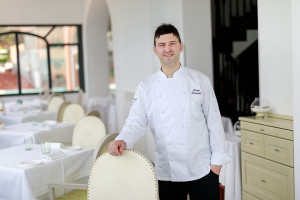 successo. Così come il nonno di Luigi Lionetti, caprese Doc, che gli fa scattare la scintilla per la cucina. «Guardando il nonno non vedevo l’ora di mettermi ai fornelli anche io. Lui faceva un ragù spettacolare oltre che un perfetto spaghetto con le vongole che ancor oggi è il mio piatto preferito». Una passione che si consolida durante uno stage scolastico presso il ristorante Da Paolino, dove a soli sedici anni distingueva già bene i vari ingredienti mettendo a punto gli insegnamenti del nonno. La sua carriera ha inizio quando, una sera, decide di andare a provare il ristorante di Gennaro Esposito che, vedendolo cenare da solo, lo interroga sulla sua passione e lo invita a lavorare con lui in inverno. Conosce tante cucine in giro per il mondo e da ognuna assorbe qualcosa senza mai dimenticare le sue radici. La sua filosofia si riassume in casa, territorio e materie prime importanti, che mette in pratica da dodici anni tra i fornelli del Monzù dell’hotel Punta Tragara, dove dirige la sua brigata con armonia cercando di far emozionare i clienti con il gusto. «Provate la sensazione di stare seduti ad uno dei nostri tavoli e immaginate come i piatti devono uscire dalla cucina» dice ogni tanto ai suoi ragazzi. Un successo che si rinnova di anno in anno in questo hotel che è ormai la sua casa e «anche se sono a questo punto, non ho ancora fatto niente», afferma con una convinzione che non spegne la sua voglia di fare. La stessa che contraddistingue Gennaro
successo. Così come il nonno di Luigi Lionetti, caprese Doc, che gli fa scattare la scintilla per la cucina. «Guardando il nonno non vedevo l’ora di mettermi ai fornelli anche io. Lui faceva un ragù spettacolare oltre che un perfetto spaghetto con le vongole che ancor oggi è il mio piatto preferito». Una passione che si consolida durante uno stage scolastico presso il ristorante Da Paolino, dove a soli sedici anni distingueva già bene i vari ingredienti mettendo a punto gli insegnamenti del nonno. La sua carriera ha inizio quando, una sera, decide di andare a provare il ristorante di Gennaro Esposito che, vedendolo cenare da solo, lo interroga sulla sua passione e lo invita a lavorare con lui in inverno. Conosce tante cucine in giro per il mondo e da ognuna assorbe qualcosa senza mai dimenticare le sue radici. La sua filosofia si riassume in casa, territorio e materie prime importanti, che mette in pratica da dodici anni tra i fornelli del Monzù dell’hotel Punta Tragara, dove dirige la sua brigata con armonia cercando di far emozionare i clienti con il gusto. «Provate la sensazione di stare seduti ad uno dei nostri tavoli e immaginate come i piatti devono uscire dalla cucina» dice ogni tanto ai suoi ragazzi. Un successo che si rinnova di anno in anno in questo hotel che è ormai la sua casa e «anche se sono a questo punto, non ho ancora fatto niente», afferma con una convinzione che non spegne la sua voglia di fare. La stessa che contraddistingue Gennaro 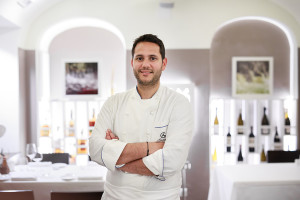 Amitrano che, quest’anno, raddoppia la sua cucina con una nuova sede affacciata sulla baia di Marina Piccola. Per lui la passione per la cucina è di famiglia, le prime esperienze iniziano nel ristorante dei genitori dove il padre che era chef è stato il suo primo maestro. «Il primo lavoro che mi hanno messo a fare era lavare le patate e l’insalata, poi a dodici anni mi sono cimentato con le pizze». Dopo alcune esperienze, a diciotto anni approda a Casa Vissani dove inizia come stagista fino a diventare sous-chef per poi girare l’Europa con il maestro che gli affida l’apertura di alcuni ristoranti come quello di Capri. Qui scocca la scintilla sia per l’isola che per Marianna, la sua compagna di vita. Da Antonio Mellino impara l’eccezionalità delle materie prime, mentre da Alain Ducasse l’organizzazione della cucina francese che racchiude nel suo primo ristorante situato nella parte più antica dell’isola. Una nuova avventura che inizia al fianco di Marianna condividendo tutto, dalla scelta del menù, agli arredi e ai vini. Tra i vicoletti capresi esprime tutta la sua fantasia che ha due sole parole d’ordine: semplicità e qualità.
Amitrano che, quest’anno, raddoppia la sua cucina con una nuova sede affacciata sulla baia di Marina Piccola. Per lui la passione per la cucina è di famiglia, le prime esperienze iniziano nel ristorante dei genitori dove il padre che era chef è stato il suo primo maestro. «Il primo lavoro che mi hanno messo a fare era lavare le patate e l’insalata, poi a dodici anni mi sono cimentato con le pizze». Dopo alcune esperienze, a diciotto anni approda a Casa Vissani dove inizia come stagista fino a diventare sous-chef per poi girare l’Europa con il maestro che gli affida l’apertura di alcuni ristoranti come quello di Capri. Qui scocca la scintilla sia per l’isola che per Marianna, la sua compagna di vita. Da Antonio Mellino impara l’eccezionalità delle materie prime, mentre da Alain Ducasse l’organizzazione della cucina francese che racchiude nel suo primo ristorante situato nella parte più antica dell’isola. Una nuova avventura che inizia al fianco di Marianna condividendo tutto, dalla scelta del menù, agli arredi e ai vini. Tra i vicoletti capresi esprime tutta la sua fantasia che ha due sole parole d’ordine: semplicità e qualità.
Piatti puliti e mediterranei che racchiudano la tradizione italiana e facciano sentire a casa gli ospiti. «La cucina è una questione di identità» dice, «io non mi racconto, sono i miei piatti che devono parlare». Il suo piatto preferito? Un risotto burro e parmigiano.
Il burro ritorna anche nella pietanza preferita di Stefano Mazzone,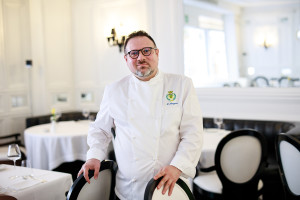 la pasta al burro. Oggi chef del ristorante Rendez Vous e della Colombaia del Grand Hotel Quisisana, siciliano nel sangue ma cresciuto a Treviso, aveva quest’isola scritta nel destino senza saperlo. Si appassiona alla cucina durante un corso scolastico di pasticceria e una graffa è il primo dolce che realizza. Dopo aver intrapreso varie strade capisce che non può fare a meno di stare tra i fornelli e inizia a lavorare in un ristorante vicino casa, finché non arriva l’occasione di affiancare Gualtiero Marchesi, in quel periodo consulente proprio per il Quisisana. La sua formazione fa tappa da Heinz Beck, da Cristoph Bob, da Andrea Berton fino a Venezia dove «conosco una persona molto importante per il mio percorso. Un giovanissimo Antonino Cannavacciuolo in viaggio di nozze, che mi fa molti complimenti». Poi è la volta di Taormina, e proprio qui riceve una telefonata da Capri. Da quando ha messo piede sull’isola la prima volta sono passati tredici anni. Soltanto dopo ha scoperto che il deus ex machina di quella telefonata era stato proprio Cannavacciuolo, memore della sua cucina. La sua creatività? Si esprime tutta nella negazione e nella difficoltà, come avere a disposizione pochissimi ingredienti. Da sempre appassionato di storia, compie ricerche sui vecchi menù facendosi mentore della tradizione campana e caprese, tutta da assaporare nei suoi piatti, dal polpo e patate fino al timballo di pasta passando per la cucina futurista perché per lui «il rapporto con il passato è molto importante».
la pasta al burro. Oggi chef del ristorante Rendez Vous e della Colombaia del Grand Hotel Quisisana, siciliano nel sangue ma cresciuto a Treviso, aveva quest’isola scritta nel destino senza saperlo. Si appassiona alla cucina durante un corso scolastico di pasticceria e una graffa è il primo dolce che realizza. Dopo aver intrapreso varie strade capisce che non può fare a meno di stare tra i fornelli e inizia a lavorare in un ristorante vicino casa, finché non arriva l’occasione di affiancare Gualtiero Marchesi, in quel periodo consulente proprio per il Quisisana. La sua formazione fa tappa da Heinz Beck, da Cristoph Bob, da Andrea Berton fino a Venezia dove «conosco una persona molto importante per il mio percorso. Un giovanissimo Antonino Cannavacciuolo in viaggio di nozze, che mi fa molti complimenti». Poi è la volta di Taormina, e proprio qui riceve una telefonata da Capri. Da quando ha messo piede sull’isola la prima volta sono passati tredici anni. Soltanto dopo ha scoperto che il deus ex machina di quella telefonata era stato proprio Cannavacciuolo, memore della sua cucina. La sua creatività? Si esprime tutta nella negazione e nella difficoltà, come avere a disposizione pochissimi ingredienti. Da sempre appassionato di storia, compie ricerche sui vecchi menù facendosi mentore della tradizione campana e caprese, tutta da assaporare nei suoi piatti, dal polpo e patate fino al timballo di pasta passando per la cucina futurista perché per lui «il rapporto con il passato è molto importante».
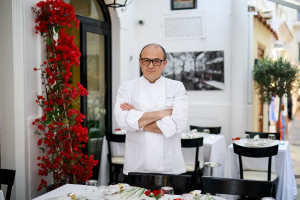 Franco Aversa nasce con la passione per la cucina nel sangue, «già da piccolissimo mi piaceva cucinare e preparavo piccole cose», racconta. Originario di una famiglia di contadini ha uno stretto rapporto con la terra. La sua figura ispiratrice è la madre, orchestratrice di ogni tavolata. «Ogni volta mangiare era una festa, in particolare quando si faceva la vendemmia o era il momento dell’uccisione dei maiali». Dopo un’esperienza in un ristorante vicino casa, decide di partire per Monaco di Baviera per andare a lavorare in un piccolo ristorante italiano. Solo più tardi nella sua storia arriva Capri, dove conosce Mia. Loro due insieme portano avanti la tradizione dell’accoglienza e del buon gusto della famiglia D’Alessio nel ristorante Aurora. «Non abbiamo mai stravolto il menù con ingredienti non territoriali. Proponiamo sempre la parmigiana di melanzane, la scarola farcita, i fiori di zucca e l’introvabile mozzarella in carrozza». La sua filosofia di cucina è quella di utilizzare pochi ingredienti, semplici e genuini. Una cucina caprese fatta bene dove il raviolo è realizzato con la migliore caciotta, maggiorana appena raccolta e il pomodoro giusto. Sapori isolani che vincono facendo dello chef e di questo ristorante il punto di riferimento di tanti vip.
Franco Aversa nasce con la passione per la cucina nel sangue, «già da piccolissimo mi piaceva cucinare e preparavo piccole cose», racconta. Originario di una famiglia di contadini ha uno stretto rapporto con la terra. La sua figura ispiratrice è la madre, orchestratrice di ogni tavolata. «Ogni volta mangiare era una festa, in particolare quando si faceva la vendemmia o era il momento dell’uccisione dei maiali». Dopo un’esperienza in un ristorante vicino casa, decide di partire per Monaco di Baviera per andare a lavorare in un piccolo ristorante italiano. Solo più tardi nella sua storia arriva Capri, dove conosce Mia. Loro due insieme portano avanti la tradizione dell’accoglienza e del buon gusto della famiglia D’Alessio nel ristorante Aurora. «Non abbiamo mai stravolto il menù con ingredienti non territoriali. Proponiamo sempre la parmigiana di melanzane, la scarola farcita, i fiori di zucca e l’introvabile mozzarella in carrozza». La sua filosofia di cucina è quella di utilizzare pochi ingredienti, semplici e genuini. Una cucina caprese fatta bene dove il raviolo è realizzato con la migliore caciotta, maggiorana appena raccolta e il pomodoro giusto. Sapori isolani che vincono facendo dello chef e di questo ristorante il punto di riferimento di tanti vip.
Ricordi, casa e famiglia. Spesso la storia di uno chef inizia così, come per Salvatore Aprea che racconta: «sono cresciuto e 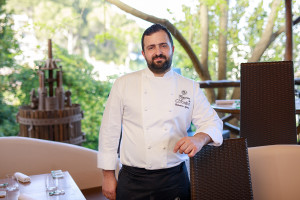 quasi nato in un ristorante, quello dei miei genitori, a Capri. Ho respirato cucina sin da quando ero piccolo; forse un po’ mi ha condizionato ma conta sempre la volontà e la passione nel fare le cose». Terminata la scuola, decide di lasciare l’isola alla ricerca di posti che gli possano dare un’esperienza diversa. Si sposta da Roma agli Stati Uniti passando per stellati e hotel di lusso dove apprende le basi della cucina francese, fino ad Heinz Beck dove cerca di imparare tutti i segreti del suo palato sopraffino. Nel 2013 decide di riaprire il ristorante di famiglia, Da Tonino, che cura con il fratello Gennaro, custode della cantina e la sua compagna Margherita. La sua cucina è fatta di sapori campani con un tocco di internazionalità grazie ad abbinamenti e consistenze. Quando Salvatore non è in cucina viaggia alla ricerca di nuovi sapori da sposare con la sua terra. «Il viaggio che mi ha lasciato di più è stato quello fatto in Perù, con i suoi contrasti e l’acidità delle pietanze. Quando si assaggia un piatto nuovo si incrementa la conoscenza e si possiede qualcosa in più che servirà per un nuovo menù». Tra le sue creazione preferite il tortello cacio e pepe con cozze e lime, il polpo alla griglia con patata peruviana e salsa di rafano, e una pasta e patate con frutti di mare e agrumi. Ma anche la Capri di sempre, quella del coniglio ormai quasi scomparso dai ristoranti, della quaglia e il raviolo, fatto secondo tradizione. «È così perfetto che non si può aggiungere niente».
quasi nato in un ristorante, quello dei miei genitori, a Capri. Ho respirato cucina sin da quando ero piccolo; forse un po’ mi ha condizionato ma conta sempre la volontà e la passione nel fare le cose». Terminata la scuola, decide di lasciare l’isola alla ricerca di posti che gli possano dare un’esperienza diversa. Si sposta da Roma agli Stati Uniti passando per stellati e hotel di lusso dove apprende le basi della cucina francese, fino ad Heinz Beck dove cerca di imparare tutti i segreti del suo palato sopraffino. Nel 2013 decide di riaprire il ristorante di famiglia, Da Tonino, che cura con il fratello Gennaro, custode della cantina e la sua compagna Margherita. La sua cucina è fatta di sapori campani con un tocco di internazionalità grazie ad abbinamenti e consistenze. Quando Salvatore non è in cucina viaggia alla ricerca di nuovi sapori da sposare con la sua terra. «Il viaggio che mi ha lasciato di più è stato quello fatto in Perù, con i suoi contrasti e l’acidità delle pietanze. Quando si assaggia un piatto nuovo si incrementa la conoscenza e si possiede qualcosa in più che servirà per un nuovo menù». Tra le sue creazione preferite il tortello cacio e pepe con cozze e lime, il polpo alla griglia con patata peruviana e salsa di rafano, e una pasta e patate con frutti di mare e agrumi. Ma anche la Capri di sempre, quella del coniglio ormai quasi scomparso dai ristoranti, della quaglia e il raviolo, fatto secondo tradizione. «È così perfetto che non si può aggiungere niente».
Con Costanza tra i fornelli
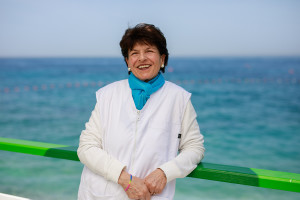 «È da quando avevo 14 anni che sono lì giù. Ho iniziato un po’ alla volta. Lavavo i piatti, spadellavo, facevo il caffè, poi piano piano…» racconta la signora Costanza, l’ultima donna ancora ai fornelli di un ristorante caprese, con il tono paziente dell’esperienza e del saper fare. Ad insegnarle tutto è stata nonna Margherita, la suocera, che le è stata sempre vicino, passo dopo passo, e oggi sono quindici anni che la cucina dei Bagni di Tiberio è tutta orchestrata da lei.
D’estate la sua casa è questo stabilimento balneare e ristorante, il primo dell’isola, che ha ottenuto la licenza nel 1926. Un luogo lontano dal tempo, adagiato sulle rovine di una delle ville imperiali di Tiberio, intimo, dove si trovano ancora racchiusi sapori autentici e genuini. «Faccio tutto solo e sempre con amore» racconta Costanza, anima della cucina e del luogo. La sua giornata inizia alle sei del mattino con l’impasto delle graffe, una soffice zeppola fritta ricoperta di zucchero che viene servita per le undici. È così buona che, per poter essere sicuri di gustarla, deve essere prenotata in anticipo. «L’impasto della graffa bisogna sentirlo in mano, perché ogni giorno è diverso in base alla patata, al tempo, all’umidità». In questo angolo di Capri la semplicità è rimasta la stessa di quando si cucinavano piatti di pesce con il pescato delle barche che ormeggiavano. Ravioli capresi, spaghetto con le zucchine, aumm aumm, tubettoni fagioli e cozze, spaghetto con le vongole e gnocchetti alla sorrentina, grigliata di pesce e pesce al sale. «Io vado sul classico e faccio tutte cose sfiziose» dice Costanza mentre racconta la bontà della parmigiana di melanzane e della peperonata. Un luogo che preserva un tempo antico, nel sorriso del marito e nella precisione del figlio Carmine mentre al comando c’è lei, Costanza, una donna che non sa fare altro che cucinare con il cuore, come se cucinasse per la sua famiglia.
«È da quando avevo 14 anni che sono lì giù. Ho iniziato un po’ alla volta. Lavavo i piatti, spadellavo, facevo il caffè, poi piano piano…» racconta la signora Costanza, l’ultima donna ancora ai fornelli di un ristorante caprese, con il tono paziente dell’esperienza e del saper fare. Ad insegnarle tutto è stata nonna Margherita, la suocera, che le è stata sempre vicino, passo dopo passo, e oggi sono quindici anni che la cucina dei Bagni di Tiberio è tutta orchestrata da lei.
D’estate la sua casa è questo stabilimento balneare e ristorante, il primo dell’isola, che ha ottenuto la licenza nel 1926. Un luogo lontano dal tempo, adagiato sulle rovine di una delle ville imperiali di Tiberio, intimo, dove si trovano ancora racchiusi sapori autentici e genuini. «Faccio tutto solo e sempre con amore» racconta Costanza, anima della cucina e del luogo. La sua giornata inizia alle sei del mattino con l’impasto delle graffe, una soffice zeppola fritta ricoperta di zucchero che viene servita per le undici. È così buona che, per poter essere sicuri di gustarla, deve essere prenotata in anticipo. «L’impasto della graffa bisogna sentirlo in mano, perché ogni giorno è diverso in base alla patata, al tempo, all’umidità». In questo angolo di Capri la semplicità è rimasta la stessa di quando si cucinavano piatti di pesce con il pescato delle barche che ormeggiavano. Ravioli capresi, spaghetto con le zucchine, aumm aumm, tubettoni fagioli e cozze, spaghetto con le vongole e gnocchetti alla sorrentina, grigliata di pesce e pesce al sale. «Io vado sul classico e faccio tutte cose sfiziose» dice Costanza mentre racconta la bontà della parmigiana di melanzane e della peperonata. Un luogo che preserva un tempo antico, nel sorriso del marito e nella precisione del figlio Carmine mentre al comando c’è lei, Costanza, una donna che non sa fare altro che cucinare con il cuore, come se cucinasse per la sua famiglia.
Yes, Chef!
Stories, anecdotes and dishes. Six Capri stories, six different styles of cooking. Where the most important ingredient is always passion
by Antonella Maresca | photos by Davide Esposito
Spaghetto con le vongole “fujute” (Spaghetti with ‘escaped’ clams). In the traditional cuisine, if there were no clams, there was still the goodness of spaghetti with garlic and olive oil. That’s the flavour of Capri cuisine. Simple, like the authenticity of its ingredients, difficult to get just right, and as good as the last strand of spaghetti on the plate. A strand made with durum wheat flour, with curiosity, identity, sublime raw materials and simplicity all along its length. Cooking styles that are all different from each other, yet have the same foundations: passion and the desire always to do it better. The sea surrounding the island shapes the interpreters of the island cuisine, or leads them to its shores. There are those who were born here, those who came here on a trip, those who felt called here as though by some muse, those who fell in love with the island when they first set foot on its calcareous rocks, those who felt enfolded within its magnetism, who found love and set down roots here, and those who have rediscovered the South that they had left behind them. Six chefs, six Capri stories, six different cooking styles. Different hands that tell of their stories, their experiences and their development through the dishes they serve at the table, course after course, creation after creation.
Winter is the heart of the Capri cuisine. When the island is resting, its chefs go off in search of flavours, emotions and colours. In new lands and new kitchens, they discover things they can bring back to the island: what ingredient to add, what flavours to match, what store of knowledge to bring so that the island can be savoured with new eyes, because, after they have travelled around the world in winter, in summer it’s the world that comes and sits at their tables. “When you cook, you transmit your true self. You need to do so with a light spirit and with a beating heart,” says Andrea Migliaccio, now executive chef of the Riccio restaurant and the Olivo restaurant at the Capri Palace, both Michelin-starred. He is originally from another island in the Gulf, Ischia, and grew up with his grandmother Tina, who taught him to appreciate the aroma of the Neapolitan ragù (meat sauce), of aubergine parmigiana and fried meat balls, as she got him to help her with the traditional home cooking, with its extra helpings of olive oil and the odd chipped plate. It was here that he acquired the deft manual skills that he developed further in his first experiences as a chef, particularly during his time with Nino Di Costanzo, from whom he learned the care, aesthetics and art of plating. He first came to Capri in 2005, having never set foot on the island before, when he came to work with Chef Oliver Glowing and fell in love with the philosophy at the Capri Palace.
Not long afterwards he was put in charge of the kitchen of the Riccio, where he spent days letting himself be inspired by the location, just a short distance from the Grotta Azzurra, before devising a seafood menu that was elegant and clean, Mediterranean and traditional. Later, he also started supervising the kitchen at the Olivo, with a more complex and structured menu, assisted by Salvatore Elefante and Giovanni Bavuso. And his favourite creation? He’s still looking for it, as he submits his new ideas to his grandmother, who is very proud of his success. Equally proud is the grandfather of Luigi Lionetti, a Capri native, who sparked his grandson’s passion for cooking. “When I was watching my grandfather, I couldn’t wait to get going at the cooker myself. He used to make a fantastic ragù as well as a perfect spaghetti with clams, which is still my favourite dish today.” His passion was reinforced during a period of school work experience at the Da Paolino restaurant where, at just sixteen years old, he had already mastered the various different ingredients, putting his grandfather’s teaching to the test. His career started when, one evening, he decided to go and try out Gennaro Esposito’s restaurant; when Esposito saw him dining alone, he questioned him about his passion, and invited him to come and work with him in the winter. Lionetti has discovered many cuisines around the world, and has absorbed something from each of them, without ever forgetting his roots. His philosophy can be summed up as home, the local territory and high quality raw materials, a philosophy that he has been putting into practice for the last twelve years in the kitchen of the Monzù restaurant, in the Punta Tragara hotel, where he leads his team with harmony, trying to enthral the customers with his flavours. “Try what it feels like to sit at one of our tables, and imagine how the dishes should come out of the kitchen,” he says to his youngsters every so often. His success is renewed year after year in this hotel that has now become his home; “Even though I’ve got to this point, I still haven’t achieved anything yet,” he affirms, with a conviction that does not quench his desire to succeed. It’s that same desire to succeed that is felt by Gennaro Amitrano, who has doubled his cooking this year with a new restaurant overlooking Marina Piccola harbour. For him, the passion for cooking runs in the family: his first experiences started in his parents’ restaurant where his father, the chef, was his first teacher.
“The first task he set me to do was washing the potatoes and the salad; then, when I was twelve, I had a go making pizzas.” After a range of experiences, at eighteen years old he arrived at Casa Vissani, where he began as a trainee and worked up to become sous-chef; after this, he went around Europe with the great chef, who entrusted him with the opening of several restaurants, such as the one on Capri. It was here that his love for the island and for Marianna, his lifetime companion, were kindled. He learned the exceptional qualities of the raw ingredients from Antonio Mellino, while Alain Ducasse taught him the system of French cuisine, which he embraced in the first restaurant that he opened himself in the oldest part of the island. It was a new adventure, and he set off on it with Marianna at his side, sharing everything from the choice of menu to the furnishings to the wines. Here among the Capri alleys, he expresses all his imagination, with just two key watchwords: simplicity and quality. Pure Mediterranean dishes that embody the Italian tradition and make guests feel at home. “Food is a question of identity,” he says. “I don’t talk about myself, it’s my dishes that must speak.” And his favourite dish? Risotto with butter and parmesan. Butter also features in Stefano Mazzone’s favourite dish: pasta with butter.
Mazzone is now chef of the Rendez Vous and La Colombaia restaurants at the Grand Hotel Quisisana; although Sicilian by blood, he grew up in Treviso, with Capri written in his destiny without knowing it. He became keen on cooking during a school pastry-making course and the first sweet he made was a graffa, the traditional Neapolitan doughnut. Having tried out a number of different career paths, he realised that he simply had to be in the kitchen, and he started work at a restaurant close to his home, until he got the chance to work with Gualtiero Marchesi, who happened to be a consultant with the Quisisana at the time. He trained under Heinz Beck, Cristoph Bob, and Andrea Berton until he reached Venice, where he met “someone very important for my career. It was a youthful Antonino Cannavacciuolo on his honeymoon, and he paid me a lot of compliments on my cooking.” Mazzone then went to Taormina, and it was there that he received a telephone call from Capri. Thirteen years have passed since he first set foot on the island. It was only later that he discovered that the deus ex machina behind that telephone call was Cannavacciuolo himself, who remembered his cooking. Where does his creativity derive from? It is expressed entirely in denial and difficulty, such as only having a few ingredients available. He has always been keen on history, and carries out research into old menus, making himself a mentor of Campania and Capri tradition: all of it can be tasted in his dishes, from octopus and potatoes to timballo di pasta (pasta in a pastry crust), with some Futurist cuisine too, because for him “the relationship with the past is very important.” Franco Aversa was born with a passion for cooking in his blood: “Even when I was very small, I liked cooking and making little things,” he tells me. He comes from a peasant family and has a strong bond with the land. His inspiration is his mother, who used to orchestrate every special dinner. “It was a feast every time we ate, especially when we were harvesting the grapes or it was time to kill the pigs.” After gaining experience in a nearby restaurant, he decided to set off for Munich, to work in a small Italian restaurant. Capri only made an appearance later on in his story, and it was there that he met Mia. Together they carry on the tradition of hospitality and the D’Alessio family’s good taste in the Aurora restaurant. “We’ve never distorted the menu with ingredients that don’t come from the local area. We always offer aubergine parmigiana, stuffed endive, courgette flowers and mozzarella “in carrozza” (“in a carriage” – a kind of fried mozzarella sandwich) that is impossible to find elsewhere.” His cooking philosophy is to use just a few, simple and authentic ingredients. It is Capri food cooked really well, where the ravioli is made with the best caciotta cheese, freshly picked marjoram and the right tomato. Winning island flavours that have made this chef and this restaurant a key port of call for VIPs. Memories, home and family. That is often how the story of a chef begins, and it is the case with Salvatore Aprea, who tells me: “I grew up, in fact I was practically born, in a restaurant, my parents’ restaurant on Capri. I have lived and breathed cooking since I was a small child; perhaps I was conditioned to some extent in that sense, but enthusiasm and passion are also important for achieving things.” After finishing school, he decided to leave the island and go in search of jobs that could give him different experience. He moved from Rome to the United States, working in Michelin-starred restaurants and luxury hotels where he learned the basics of French cuisine, until he came to Heinz Beck where he tried to learn all the secrets of the chef’s ultra-refined palate. In 2013 he decided to reopen the family restaurant, Da Tonino, which he runs together with his brother Gennaro, who looks after the wine cellar, and his companion Margherita. His cuisine consists of Campanian flavours with an international touch, thanks to the combinations and textures. When Salvatore isn’t cooking he goes travelling in search of new flavours to match with his local territory. “The trip that gave me the most was one to Peru, with its contrasts and the acidity of the dishes. When you taste a new dish, you increase your knowledge and possess something more, that will serve for a new menu.” Among his favourite creations are tortelli with cheese and pepper served with mussels and lime, grilled octopus with Peruvian potatoes and radish sauce, and a pasta and potatoes dish served with shellfish and citrus fruits. But also the classic Capri dishes like rabbit, that has now almost disappeared from restaurants, quail, and ravioli made in the traditional way. “It’s so perfect that you can’t add anything to it.”






